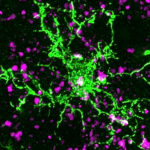Unlocking antibody diversity: chromatin loops, V(D)J recombination, and class switching

A new study from the laboratory of Frederick Alt, PhD, of the Program in Cellular and Molecular Medicine (PCMM) at Boston Children’s Hospital reveals yet another way in which chromatin regulation — changing the configuration of our DNA and its packaging — enables our immune systems to produce its wide-ranging arsenal of antibodies.
In September in the journal Nature, the Alt lab demonstrated how the formation of new loops in chromatin, known as loop extrusion, facilitates the process of V(D)J recombination, allowing bits of genetic code to be mixed and matched to generate new antibodies. The new study, published in Nature on October 30, finds that chromatin looping is also involved in another major method of antibody diversification, known as class switching.
Once V(D)J recombination assembles a specific antibody against a pathogen, class switching adjusts the class of antibody depending on where the infection is located and what kind of response is needed. For example, an infection in the mouth might trigger B cells to make IgA antibodies, found in mucous membranes, instead of IgM antibodies, found mainly in the blood and lymph fluid.
“Until now the mechanism of class switching was totally mysterious,” says Alt.
Together, the papers establish antibody formation as a poster child for the emerging field of chromatin loop extrusion and gene regulation — in which far-flung parts of the genome come together to create a rich repertoire of antibodies. “Loop extrusion contributes to both processes, but in totally different ways,” says Alt.
For details, read this Nature News & Views piece and this article on PCMM’s website.
Related Posts :
-

Building better antibodies, curbing autoimmunity: New insights on B cells
When we’re vaccinated or exposed to an infection, our B cells spring into action, churning out antibodies that are ...
-

Exposing a tumor’s antigens to enhance immunotherapy
Successful immunotherapy for cancer involves activating a person’s own T cells to attack the tumor. But some tumors have ...
-

Could we intervene in Huntington’s disease before symptoms appear?
Huntington’s disease is the most common single-gene neurodegenerative disorder and is characterized by motor and cognitive deficits and psychiatric ...
-

Could the right dietary fat help boost platelet counts?
Aside from transfusions, there currently is no way to boost people’s platelet counts, leaving them at risk for uncontrolled ...





